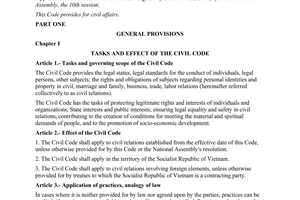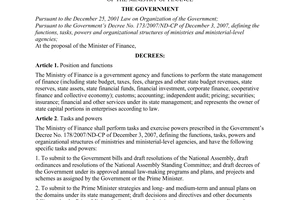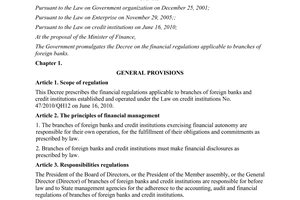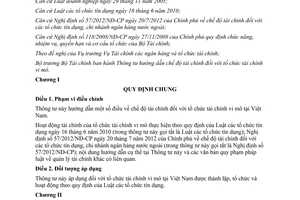Circular No. 06/2013/TT-BTC guiding financial regime for microfinance institutio đã được thay thế bởi Circular 18/2018/TT-BTC financial policies applicable to microfinance institutions và được áp dụng kể từ ngày 29/03/2018.
Nội dung toàn văn Circular No. 06/2013/TT-BTC guiding financial regime for microfinance institutio
|
MINISTRY OF FINANCE |
SOCIALIST REPUBLIC OF VIETNAM |
|
No:.06/2013/TT-BTC |
Hanoi, January 09, 2013 |
CIRCULAR
GUIDING FINANCIAL REGIME FOR MICROFINANCE INSTITUTIONS
Pursuant to the Law on Enterprises dated November 29, 2005;
Pursuant to the Law on Credit Institutions dadted June 16, 2010;
Pursuant to the Decree No.57/2012/ND-CP dated 7/20/2012 of the Government on financial regime for the credit institutions and foreign bank branches;
Pursuant to the Decree No.118/2008/ND-CP dated 11/27/2008 of the Government defining the functions, tasks, powers and organizational structure of the Ministry of Finance;
At the request of the Director of Finance on Banks and Financial Institutions;
The Minister of Finance issues the Circular to guide the financial regime for microfinance institutions.
Chapter I
GENERAL PROVISIONS
Article 1. Scope of regulation
This Circular guides a number of Articles on financial regime for the microfinance institutions in Vietnam.
Financial activities of the microfinance institutions shall comply with the provisions of the Law on Credit Institutions dated June 16, 2010 (herein referred to as the Law on Credit Institutions); the Decree No.57/2012/ND-CP dated July 20, 2012 of the Government on the financial regime for the credit institutions and foreign bank branches (in the Circular referred to as the Decree No.57/2012/ND-CP); specific guidance in this Circular and other related legal documents on financial management.
Article 2. Application subjects
This Circular applies to the microfinance institutions in Vietnam that were established, organized and operating under the Law on Credit Institutions.
Chapter II
SPECIFIC PROVISIONS
Article 3. Capital of the microfinance institutions
1. Equity capital.
a) Charter capital.
b) The difference in the exchange rate in accordance with the law provisions.
c) The difference in revaluation of assets is the difference between the book value of the assets compared with value of revaluation of assets when having the decision of the State.
d) The additional reserve funds for charter capital, funds for investment and development, the financial reserve fund.
e) Undistributed profits.
g) Other capital under the legal ownership of microfinance institutions in accordance with the law provisions.
2. Capital raised in the form.
a) Receipt of deposits in Vietnamese dong under the following forms:
- Compulsory savings in accordance with the provisions of the microfinance institutions.
- Deposits of organizations and individuals including the deposit by voluntariness of microfinance clients (except for deposits for the purpose of payment).
b) Loans from the credit institutions, financial institutions and other domestic or foreign individuals and organizations in accordance with the law provisions.
c) Capital received from entrustment to lend under the programs and projects of the Government, the domestic or foreign organizations and individuals.
Article 4. Use of capital, assets
1. The microfinance institutions are responsible for the management, use, monitoring of all existing assets and capital, performing accounting in accordance with the current accounting regime; reflecting the full, accurate and timely use, changes in capital and assets in the course of business; identifying clear responsibilities and sanctions of handling of each department, individual for each case of damage or loss of assets, capital of the microfinance institutions.
2. The microfinance institutions are used working capital to serve the business under the provisions of the Law on Credit Institutions, the Decree No.57/2012/ND-CP and the specific guidances in this Circular on the principles of assurance of safety and capital development.
a) During the operation, business, the microfinance institutions must remain limited investment in the construction, procurement of fixed assets in direct service to the business by the principle of: residual value of fixed assets shall not exceed 50% of the charter capital and additional reserve fund for charter capital of the microfinance institutions.
b) For real estates held by the handling of the loans as stipulated in Clause 3, Article 132 of the Law on Credit Institutions:
- For real estates held temporarily by the microfinance institutions to sell, transfer to withdraw funds, the microfinance institutions shall not account increase of assets, shall not depreciate.
- For real estates acquired by the microfinance institutions in direct service to the business, the microfinance institutions shall account increase of assets, shall depreciate in accordance with the law provisions and ensure limited investment in construction, procurement of fixed assets in accordance with provisions of point a, Clause 2 of this Article.
c) The microfinance institutions implement the measures to ensure the safety of capital as defined in Article 8 of the Decree No.57/2012/ND-CP The appropriation of provisions in cost, the microfinance institutions shall comply with the following specific provisions:
- For provision for risks in banking operation, the microfinance institutions shall set up and use the provision for risks as prescribed by the State Bank Governor of Vietnam, after agreeing with the Minister of Finance.
- For provision for devaluation of stocks, provision for loss of long-term investments, provision for bad debts (other than provision for risks in banking operation): the microfinance institutions appropriate reserve funds according to the general provisions applicable to the enterprises.
d) Lease, mortgage, pledge of assets: the microfinance institutions have the right to lease, mortgage, pledge assets of the microfinance institutions under the provisions of the Civil Code, the Law on the Credit Institutions and other provisions of law to ensure effective, safe capital development.
đ) For leased assets, the microfinance institutions are responsible for the management, maintenance or use as agreed with clients in accordance with the provisions of law.
e) Transfer or liquidation of assets:
- The transfer or liquidation of the assets of the microfinance institutions shall comply with the provisions of the law and the provisions of the Charters of the microfinance institutions.
- The microfinance institutions are allowed to transfer assets to recover funds used for more effective business purpose.
- The microfinance institutions are allowed to liquidate assets of degraded, poor quality; damaged assets that are unable to recover; technically obsolete assets without the need to use or used without effectiveness and unable to be sold as is; assets used beyond their use time in accordance with provisions and can not continue to be used. When liquidating assets, the microfinance institutions must establish liquidation Council.
- For assets required by law to make auction sale as transfer or liquidation, the microfinance institutions must hold the auction in accordance with the law provisions.
Article 5. Revenue management
1. Revenues of the microfinance institutions include the revenues provided for in Article 15 of the Decree No.57/2012/ND-CP specifically:
a) ) Revenue from business activities, includes:
- Revenue from credit activities: revenue from interest on deposits, interest from credit granting operation, other revenues from credit operation.
- Revenue from services includes: revenue from the service receiving entrustment to lend, revenue from provision of collection and remittance services and transfer money to microfinance clients, revenue from financial advisory services related to the field of microfinance activities, revenue from agents providing insurance services.
- Revenue from exchange rate differences in accordance with provisions of accounting standards and the provisions of the current law.
- Revenue from other business activities, including: revenue from renting out assets and revenue from other business activities based on operation license.
b) Other revenues include:
- Revenue from the transfer or liquidation of fixed assets.
- Revenue from the loans handled by risk reserve (including the debts that have been forgiven, now recovered).
- Revenue from the debts payable, but lost its debtors or unidentified its creditors recorded income increase.
- Revenue from fines of clients, money paid for compensation by clients due to breach of contract.
- Revenue from insurance compensation.
- Revenue from taxes paid and reduced, refunded.
- Revenue from returning the surplus amount from the provision for risks (amount required to set aside is lower than the numbers set aside) but not recorded cost decrease as prescribed by law for the provision for risks.
- Revenue from non-refundable grant for the development programs, the activities of microfinance institutions.
- Other revenues.
2. Revenue recognition principles.
a) Interest revenue from credit providing activities: microfinance institutions account the receivable interest arising in the period into income for the qualified debts which are not required to make appropriation for risks specifically as prescribed. For the receivable interest arising in the period of the remaining debts, it is not required to account income, the microfinance institutions shall monitor off-balance sheet to urge the collection; when collected, account as revenue from business.
b) Deposit interest revenue: the amount of interest receivable during the period.
c) Revenue from non-refundable funding receipt for the development programs, the activities of microfinance institutions: the amount actually collected at the time of funding receipt.
d) For revenue from the remaining activities: revenue is the entire proceeds from the sale of products, goods and provision of services generated in the period accepted to make payment by the clientss after minus (-) a commercial discount amount, reducing price of goods sold and value of sold goods to be returned (if having valid documents) regardless of whether money is collected or not.
đ) For the receivable revenues accounted for in income but when the maturity comes, they are not obtained, the microfinance institutions shall account reduction of revenue if it is in the same accounting period or account into costs if it is not in the same accounting period and tracking off-balance sheet to urge the collection. When they are collected, then account into revenue from business activities.
3. The revenues of the microfinance institutions arising in the period must have valid invoices or vouchers and must be fully accounted in sale revenue.
Article 6. Cost management
1. Expenses of the microfinance institutions, include the expenses specified in Article 16 of the Decree No.57/2012/ND-CP For some expenses, the microfinance institutions shall comply with the following guidelines:
a) Expenses for business:
- Spending on credit activities: paying for interest on deposits, interest on loans, and other expenses for the operation of providing credit.
- Spending on business of banking services: paying for the service receiving entrustment to lend, paying for fees of entrustment to lend, paying for collection and remittance services and transfer money to microfinance clients, paying for the activity to act as insurance providing agents, and paying for financial advisory services related to the field of microfinance activities.
- Spending on exchange rate differences in accordance with provisions of accounting standards and the provisions of the current law.
- Expenses for other business activities.
b) Expenses for taxes, fees and charges, including taxes, charges and fees relating to land rents (excluding corporate income tax) in accordance with the law provisions.
c) Expenses for assets:
- Expenses for depreciation of fixed assets used for business activities shall comply with the regime of management, use and appropriation for depreciation of fixed assets for enterprises.
In case of purchase for deferred payment of fixed assets: the microfinance institutions account for the difference between the total amount payable and fixed asset purchase price paid right in the cost according to the maturity except that the difference is included in the primary price of fixed assets (capitalization) in accordance with the provisions of accounting standards.
- Expenses for leasing fixed assets: Cost of lease of fixed assets shall comply with the lease contract. In case of making lump-sum payment for the rent of assets for many years, the rent is apportioned into the cost of doing business by the number of years of using assets. For the expenses related to the land lease that can not be deducted from the rent according to regulations, the microfinance institutions apportion into the cost over time using leased land.
- Expenses for maintenance and repair of fixed assets.
- Expenses for procurement; repair of tools and instruments.
- Expenses for asset insurance.
d) Expenses for employees in accordance with the law provisions, including the following items:
- Expenses for salaries, wages and other items of wage nature.
- Expenses for salary contribution: Paying for social insurance, health insurance, unemployment insurance, trade union fees.
- Expenses for allowances of unemployment to employees in accordance with the law for enterprises.
- Expenses for purchase of personal accident insurance.
- Expenses for shift meals.
- Expenses for labor protection for those who are required personal protective equipment while working.
- Expenses for uniforms for staffs working in the microfinance institutions according to regulations.
- Expenses for annual leave as prescribed by law.
- Medical expenses including the expenses for period medical examination for employees, purchase of reserve medicine and other medical expenses under the responsibility of the enterprises as prescribed by law.
- Payment of annual leave as prescribed by law.
- Other expenses for employees in accordance with the law.
đ) Expenses for management activities, public service:
- Expense for travelling expenses.
- Expense for electricity, water, telephone, materials, printing paper, stationery, printing of management forms.
- Expense for treasury, store operations.
- Expense for hiring consultants, hiring domestic or foreign experts.
- Expense for auditing.
- Expenses for training, strengthening capacity for officials and employees; including expense for training freelancers and clients within the scope of microfinance activities.
- Expenses for remuneration to freelancers under cooperation contracts or agreements between the parties.
- The commission for agents, entrusting costs must be stated in the agent contract, entrusting contract with all the reasonable and valid papers.
- Expense for the appropriation for the fund of scientific and technological development in accordance with the law provisions. The use of funds shall comply with the current regulations.
- Expense for scientific and technological research: the missing part of expense after using up the scientific and technological development fund.
- Expense for rewarding innovations, increase of labor productivity, cost savings: by the principle in accordance with the actual effectiveness; the microfinance institutions must build and publish regulations on reward and establishment of Council for initiative acceptance test.
- Expense for fire fighting and prevention.
- Expense for environmental protection.
- Expense for protection of the agencies.
- Expense for reception festivities, propaganda, advertising, marketing, promotions, foreign affairs conferences, and other costs according to regulations and required to have invoices or vouchers in accordance with the provisions of the Ministry of Finance, in association with the business results of the microfinance institutions.
- Brokerage commission costs: The expense for brokerage commissions of the microfinance institutions must be linked to economic efficiency brought by the brokerage. The microfinance institutions are based on guidelines of brokerage commission costs of the Finance Ministry, their specific conditions and characteristics to formulate Regulations on brokerage commission expense applied uniformly and publicly in the microfinance institutions. The Council of members or General Director (Director) of the microfinance institutions approves the Regulations on brokerage commission exspense applied in their units.
Those entitled to brokerage commissions are the organizations and individuals (domestic and foreign) to provide brokerage services to the microfinance institutions. Brokerage commissions are not be applied to the subjects as agents of the microfinance institutions, the customers designated, the titles of management, employees of the microfinance institutions.
The expense for brokerage commissions must be based on contract or written certification between the microfinance institutions and the recipient of brokerage commission, which must contain the basic contents: the name of the commission recipient; content of spending; spending rate; payment method; implementation and end time; responsibilities of the parties.
For the brokerage expenses for asset rental (including assets foreclosed, assets used as payment for debt): Broker spending level to rent out assets of the microfinance institutions must not exceed 5% of all proceeds from the asset leasing brought by the brokerage during the year.
For the expenses for brokerage of selling assets mortgaged, pledged: spending level for brokerage commission to sell assets mortgaged, pledged of the microfinance institutions must not exceed 1% of the actual value obtained from the sale of assets through brokerage.
e) Expenses for risk prevention: Expenses for provision for operations of the microfinance institutions as prescribed in item c, Clause 2, Article 4 of this Circular.
g) Expense for participating in organization to preserve and insure deposits as prescribed by law.
h) Other expenses:
- Expense for fees of domestic or foreign associations and industries participated in by the microfinance institutions according to the fees prescribed by these associations.
- Expense for the activities of Party and unions in the microfinance institutions (expenditures outside the budget of the Party organization, unions paid from specified sources).
- Expense for the items accounted as revenue but not collected actually and not accounted reduction of revenue.
- Expense for payable liabilities, determined as loss of creditors and accounted into income but then identified its creditors.
- Expense for the transfer and liquidation of assets (if any), including the residual value of fixed assets to be liquidated, transferred.
- Expense for fees of debt collection service to the organizations allowed performing debt collection service in accordance with the law provisions; expense for recovery of the forgiven loans, bad debt recovery costs.
- Expense for fines from administrative violations; fines and damages compensation for breach of economic contract under responsibilities of the credit institutions.
- Expense for the recovery of forgiven debts, recovery of bad debts.
- Expense for handling the remaining asset losses after offsetted by the sources as provided for in Article 11 of the Decree No.57/2012/ND-CP.
- Expense for social work including funding for health, education, funding for disaster recovery, for care for, support, improvement of social security for the poor and other expenses in accordance with the law provisions.
- Expense for court fees, fees for execution.
- Other expenses.
2. Principle on recorgnition of expenses.
a) The expenses of the microfinance institutions are the expenses actually incurred during the period related to business activities.
b) The expenses recorded in costs of doing business of the microfinance institutions must comply with the principle of matching of revenue and expenses and with sufficient lawful invoices, vouchers in accordance with law provisions.
3. Microfinance institutions are not included in the cost of the following items:
a) The expenses not related to the business of the microfinance institutions.
b) Expenses without valid vouchers.
c) The fines for administrative violations that individuals must pay under the provisions of the law include: violation of traffic laws and violations of business registration regime, violations of the statistics, accounting regime, violations of the tax law and other administrative violations.
d) The items accounted as expense but not paid actually.
đ) Other reasonable expenses
Article 7. Accounting currency
The determination of the accounting currency shall comply with the provisions of Article 18 of the Decree No.57/2012/ND-CP.
Economic activities of the microfinance institutions arising in foreign currency must be converted into Vietnam dong as prescribed by law.
Article 8. Regime of accounting, statistics, auditing, reporting and financial disclosure
1. The microfinance institutions perform the accounting regime in accordance with the law provisions, record fully the original documents, update accounting books and reflect fully, timely, truthfully, accurately, objectively the financial, economic activities.
2. Fiscal year of the microfinance institutions starts on January 01 and ends on December 31 of the calendar year.
3. The microfinance institutions perform financial settlement; fully abide by the regulations on establishment and submission of financial statements to the State Bank of Vietnam under the provisions.
Chairmen of the Councils of members or the general directors (directors) of the microfinance institutions are responsible for the accuracy and truthfulness of these statements.
4. Content, the time limit for submission of financial statements:
a) Financial statements.
System of annual financial statements, mid-year financial statements and accounting reports and the time limit for submitting the reports: the microfinance institutions shall comply with the provisions of the State Bank of Vietnam on financial reporting regime toward the credit institutions.
b) Report on the result of the annual financial statement audit: the microfinance institutions send the annual financial statements audited together with the conclusions of the independent audit organizations right after the end of the audit.
c) Irregular report: At the request of the authorities.
5. Recipients of report:
a) The microfinance institutions send the financial statements to the branch of the State Bank of Vietnam where the microfinance institutions headquartered and the State Bank of Vietnam (the Agency of Inspection and Supervision of banks).
b) The microfinance institutions send the reports on the result of the annual financial statement audit to the State Bank of Vietnam and the Ministry of Finance.
Article 9. Inspection, handling of financial violations
1. Financial inspection.
a) Financial inspection form.
The financial inspection shall be performed under the following forms:
- Periodical or irregular financial inspection.
- Inspection by each subject in accordance with requirements for the financial management.
b) Financial inspection agency
- State Bank is responsible for inspecting, examining, monitoring comprehensively the activities of the microfinance institutions, including financial activities; notifying the Ministry of Finance the violations, the difficulties related to the implementation of the financial management regime detected during the inspection, examination, monitoring for the Ministry of Finance to coordinate in handling and improving the policies.
- The Ministry of Finance performs inspection under the provisions of the law on inspection; examines the issues related to financial management, compliance with financial regulations of the microfinance institutions in order to improve mechanisms for financial management of the microfinance institutions; informs the State Bank of Vietnam the inspection and examination results for coordination in handling.
2. Handling of violations.
Microfinance institutions violating financial regime, the financial report regime of the State shall be sanctioned according to the law provisions.
Article 10. Responsibility of the management agencies
1. The Ministry of Finance, State Bank implements their responsibilities under the provisions of Article 34, Article 35 of the Decree No.57/2012/ND-CP.
2. Quarterly, annually the State Bank of Vietnam shall inform the Ministry of Finance the financial situation of the microfinance institutions under the provisions of Clause 1, Article 35 of the Decree No.57/2012/ND-CP specifically with the following indicators:
a) Number of the microfinance institutions.
b) Total charter capital, the equity capital of the microfinance institutions.
c) Total assets with the rate of safety in the operation of the microfinance institutions.
d) Total outstanding loans, total deposits, non-performing loan ratio in the operation of the microfinance institutions.
đ) Total profits and the number of the microfinance institutions having profit; total loss and the number of the microfinance institutions having loss.
e) Number remitted to the State budget of the microfinance institutions (classified by the types of taxes and fees).
g) The violations of financial regime of the microfinance institutions are detected during the inspection and supervision.
h) Other concerned norms, contents.
Chapter III
IMPLEMENTATION ORGANIZATION
Article 11. Implementation organization
1. This Circular takes effect from February 25, 2013.
2. In the course of implementation, if any problems arise, the concerned bodies should report them to the Ministry of Finance for study, consideration and settlement./.
|
|
FOR MINISTER |
------------------------------------------------------------------------------------------------------
This translation is made by LawSoft and
for reference purposes only. Its copyright is owned by LawSoft
and protected under Clause 2, Article 14 of the Law on Intellectual Property.Your comments are always welcomed





